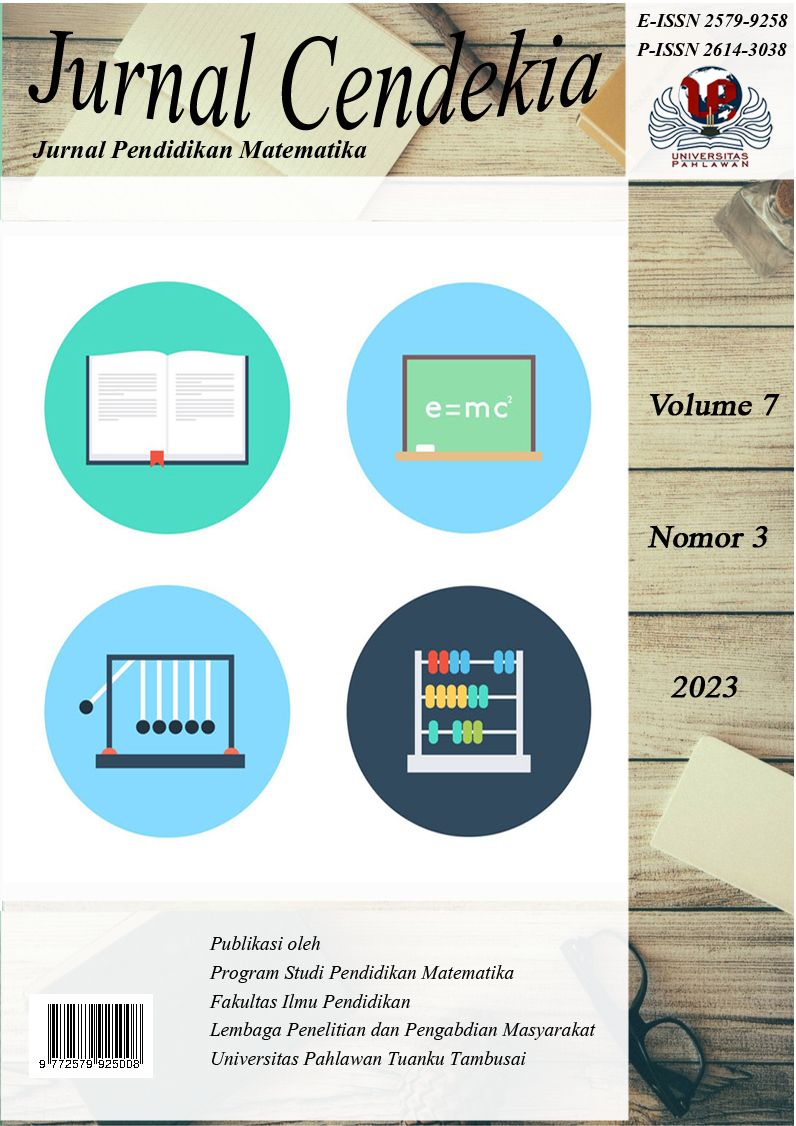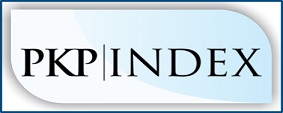Struktur Argumentasi Mahasiswa dalam Pembuktian Sifat Ketertutupan Suatu Grup
Abstract
Penelitian ini menerapkan Model Argumentasi Toulmin dalam mengidentifikasi struktur argumentasi pada pembuktian sifat ketertutupan suatu grup dengan pendekatan deduktif. Data diperoleh dari 30 mahasiswa yang menempuh mata kuliah pengantar teori gelanggang. Dari seluruh partisipan yang berpartisipasi, satu subjek dipilih berdasarkan jawaban lengkap dan benar untuk dianalisis lebih lanjut. Komponen-komponen model Toulmin diterapkan dalam analisis terhadap jawaban subjek yang dipilih. Hasil analisis menunjukkan bahwa subjek mampu merumuskan Claim yang jelas, menyajikan Warrant yang tepat dan Backing yang kuat, walaupun terdapat komponen argumentasi yang tersaji secara implisit, namun dapat diungkap dengan menggunakan Model Argumentasi Toulmin. Kelebihan penggunaan model argumentasi Toulmin dalam pembuktian deduktif terlihat dalam kemampuannya untuk merumuskan argumen yang terstruktur dan jelas. Model ini memungkinkan penjelasan yang sistematis dan memperkuat kepercayaan terhadap validitas pembuktian. Dengan adanya penelitian ini diharapkan memperkaya pemahaman tentang struktur argumentasi dalam pembuktian deduktif terhadap sifat ketertutupan grup dan menunjukkan potensi penggunaan Model Argumentasi Toulmin dalam mengidentifikasi argumentasi matematika.
Downloads
References
Structure in Solving Statistical Problems Based on Adversity Quotient. Jurnal Pendidikan Matematika, 16(2), 121–140. https://doi.org/10.22342/jpm.16.2.16633.121-140
Aberdein, A. (2005). The uses of argument in mathematics. Argumentation, 19(3), 287–301. https://doi.org/10.1007/s10503-005-4417-8
Arnawa, I. M., Yanita, Ginting, B., Yerizon, & Nita, S. (2020). Improvement a positive attitude towards abstract algebra through APOS theory approach. Journal of Physics: Conference Series, 1503(1), 012008. https://doi.org/10.1088/1742-6596/1503/1/012008
Astuti, A., & Zulhendri, Z. (2017). Analisis Kesulitan Belajar Struktur Aljabar pada Mahasiswa Semester III Jurusan Pendidikan Matematika STKIP Pahlawan Tuanku Tambusai Riau Tahun Ajaran 2015/2016. Jurnal Cendekia : Jurnal Pendidikan Matematika, 1(1), 17–23. https://doi.org/10.31004/CENDEKIA.V1I1.5
Banegas, J. A. (2013). Argumentation in Mathematics BT - The Argument of Mathematics (A. Aberdein & I. J. Dove, Ed.; hlm. 47–60). Springer Netherlands. https://doi.org/10.1007/978-94-007-6534-4_4
Bizup, J. (2009). The uses of toulmin in composition studies. College Composition and Communication, 61(1), 1–23.
CadwalladerOlsker, T. (2011). What Do We Mean by Mathematical Proof? Journal of Humanistic Mathematics, 1(1), 33–60. https://doi.org/10.5642/jhummath.201101.04
Chen, Y. T., & Wang, J. H. (2016). Analyzing with Posner’s Conceptual Change Model and Toulmin’s Model of Argumentative Demonstration in Senior High School Students’ Mathematic Learning. International Journal of Information and Education Technology, 6(6), 457–464. https://doi.org/10.7763/IJIET.2016.V6.732
Conner, A., Singletary, L. M., Smith, R. C., Wagner, P. A., & Francisco, R. T. (2014). Teacher support for collective argumentation : A framework for examining how teachers support students’ engagement in mathematical activities. Educ Stud Math, 86(2014), 401–429. https://doi.org/10.1007/s10649-014-9532-8
Faizah, S., Nusantara, T., Sudirman, S., & Rahardi, R. (2020). Exploring students’ thinking process in mathematical proof of abstract algebra based on Mason’s framework. Journal for the Education of Gifted Young Scientists, 8(2), 871–884. https://doi.org/10.17478/JEGYS.689809
Faizah, S., Rahmawati, N. D., & Murniasih, T. R. (2021). Investigasi Struktur Argumen Mahasiswa Dalam Pembuktian Aljabar Berdasarkan Skema Toulmin. AKSIOMA: Jurnal Program Studi Pendidikan Matematika, 10(3), 1466. https://doi.org/10.24127/ajpm.v10i3.3781
Findell, B. (2001). Learning and understanding in abstract algebra. Doctoral Dissertations. https://scholars.unh.edu/dissertation/51
Hamami, Y., & Morris, R. L. (2020). Philosophy of mathematical practice: a primer for mathematics educators. ZDM - Mathematics Education, 52(6), 1113–1126. https://doi.org/10.1007/S11858-020-01159-5/FIGURES/1
Hanna, G. (2018). Reflections on Proof as Explanation. Dalam A. J. Stylianides & G.
Harel (Ed.), Advances in Mathematics Education Research on Proof and Proving: An International Perspective (hlm. 3–18). Springer International Publishing. https://doi.org/10.1007/978-3-319-70996-3_1
Isnarto, Wahyudin, Suryadi, D., & Dahlan, J. A. (2014). Students’ Proof Ability: Exploratory Studies of Abstract Algebra Course. International Journal of Education and Research, 2(6). www.ijern.com
Knipping, C., & Reid, D. A. (2019). Argumentation Analysis for Early Career Researchers. Dalam G. Kaiser & N. Presmeg (Ed.), Compendium for Early Career Researchers in Mathematics Education (hlm. 3–31). Springer International Publishing. https://doi.org/10.1007/978-3-030-15636-7_1
Laamena, C. M., & Nusantara, T. (2019). Prospective mathematics teachers’ argumentation structure when constructing a mathematical proof: The importance of backing. Beta: Jurnal Tadris Matematika, 12(5), 43–59. https://doi.org/10.20414/betajtm.v12i1.272
Lee, K. S. (2016). Students’ proof schemes for mathematical proving and disproving of propositions. The Journal of Mathematical Behavior, 41, 26–44. https://doi.org/10.1016/J.JMATHB.2015.11.005
Lin, P.-J. (2018). The Development of Students’ Mathematical Argumentation in a Primary Classroom. Educação & Realidade, 43(3), 1171–1192. https://doi.org/http://dx.doi.org/10.1590/2175-623676887
Moore, R. C. (2016). Mathematics Professors’ Evaluation of Students’ Proofs: A Complex Teaching Practice. International Journal of Research in Undergraduate Mathematics Education 2016 2:2, 2(2), 246–278. https://doi.org/10.1007/S40753-016-0029-Y
Nadlifah, M., & Prabawanto, S. (2017). Mathematical Proof Construction: Students’ Ability in Higher Education. Journal of Physics: Conference Series, 895(1). https://doi.org/10.1088/1742-6596/895/1/012094
Pala, O., Aksoy, E., & Narli, S. (2021). Can the Proof Image Exist in the Absence of the Formal Proof?: Analyses of an Unsuccessful Proving Attempt. Necatibey Eğitim Fakültesi Elektronik Fen ve Matematik Eğitimi Dergisi, 15(1), 1–31. https://doi.org/10.17522/balikesirnef.843527
Pramasdyahsari, A. S., Buchori, A., & Rasiman, R. (2022). Mathematical Proving Ability of Pre-service Teachers in Online and Blended Learning. KnE Social Sciences, 2022, 1021–1031–1021–1031. https://doi.org/10.18502/KSS.V7I14.12052
Rabin, J. M., & Quarfoot, D. (2021). Sources of Students’ Difficulties with Proof By Contradiction. International Journal of Research in Undergraduate Mathematics Education, 8(3), 521–549. https://doi.org/10.1007/S40753-021-00152-X/TABLES/3
Thomas, M. O. J., Druck, I. de F., Huillet, D., Ju, M.-K., Nardi, E., Rasmussen, C., & Xie, J.
(2015). Key Mathematical Concepts in the Transition from Secondary School to University. The Proceedings of the 12th International Congress on Mathematical Education, 265–284. https://doi.org/10.1007/978-3-319-12688-3_18
Toulmin, S. E. (2003). The uses of argument: Updated edition. Dalam The Uses of Argument: Updated Edition. https://doi.org/10.1017/CBO9780511840005
Tristanti, L. B., & Nusantara, T. (2021). Argumen dalam Pembuktian. Penerbit
Deepublish.
Wasserman, N., Weber, K., Villanueva, M., & Mejia-Ramos, J. P. (2018). Mathematics teachers’ views about the limited utility of real analysis: A transport model hypothesis. The Journal of Mathematical Behavior, 50, 74–89. https://doi.org/10.1016/J.JMATHB.2018.01.004
Wittmann, E. C. (2021). When Is a Proof a Proof? Connecting Mathematics and Mathematics Education, 61–76. https://doi.org/10.1007/978-3-030-61570-3_5
Copyright (c) 2023 M. Zainul Arifin, Sudirman Sudirman, Rustanto Rahardi

This work is licensed under a Creative Commons Attribution-ShareAlike 4.0 International License.



1.jpg)














